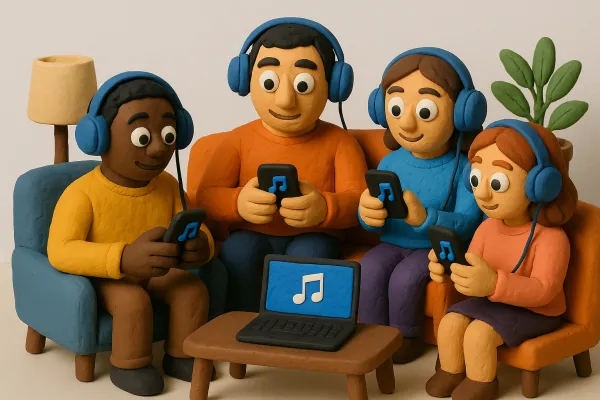Define EP in Music: Understanding the Extended Play Format and Its Significance

If you've ever wondered what an EP is in music, you're not alone. The term "EP" stands for Extended Play, and it refers to a type of music release that falls somewhere between a single and a full-length album. This format has gained popularity for various reasons, and in this article, we’ll break down everything you need to know about EPs, including their history, structure, and why artists choose to release them. Whether you're a musician or just a music lover, this guide will help you understand the significance of EPs in today's music scene.
Key Takeaways
- An EP, or Extended Play, usually contains 4 to 6 tracks, making it longer than a single but shorter than an album.
- The format originated in the 1950s with vinyl records and has evolved with technology to include digital releases.
- EPs are a cost-effective way for artists to release music without the commitment of a full album.
- They allow for artistic expression and experimentation, often showcasing a theme or concept.
- In the digital age, EPs have become more popular due to streaming services and independent artist releases.
What Is An EP In Music?
Defining The Extended Play
Okay, so what is an EP? Well, an EP, or Extended Play, is basically a musical release that's longer than a single but shorter than a full album. Think of it as the perfect middle ground. It gives artists more room to express themselves than a single allows, but without the commitment and resources needed for a full-length album. It's a sweet spot for creativity and testing the waters.
Key Characteristics of EPs
So, what makes an EP an EP? Here are a few things that usually define them:
- Track Count: EPs typically have between 4 to 6 songs. Of course, there are always exceptions, but that's the general range.
- Length: Most EPs clock in around 15 to 30 minutes. Again, not a hard rule, but a good guideline.
- Cohesion: While not as crucial as in an album, many EPs have a theme or a specific vibe that ties the songs together. It's like a mini-album experience.
EPs are a great way for artists to experiment and try out new sounds without the pressure of creating a full album. It allows for more creative freedom and can be a really fun way to engage with fans.
How EPs Differ From Singles and Albums
Let's break down the differences between EPs, singles, and albums:
| Feature | Single | EP | Album |
|---|---|---|---|
| Track Count | 1-3 | 4-6 | 8+ |
| Length | Under 10 minutes | 15-30 minutes | 30+ minutes |
| Purpose | Promote a specific song | Showcase a collection of songs | Tell a larger story, explore themes |
| Cost | Lowest | Medium | Highest |
Think of a single as a quick hello, an EP is a solid introduction, and an album is the whole story. Each has its own purpose and place in the music world.
The History Of EPs
Origins in Vinyl Records
Let's rewind a bit. The story of EPs starts back in the early days of vinyl. Record labels were trying out different sizes and formats, and the EP emerged as something in between a single and a full album. Think of it as the Goldilocks option – not too short, not too long, just right for artists who had more to say than a single allowed, but weren't ready for a full LP. The first EPs were typically seven-inch vinyl records, holding around four tracks. They offered more playing time than singles, usually clocking in between 10 and 15 minutes. These early vinyl records were a game-changer.
Evolution Through The Decades
EPs really took off in the '50s and '60s. They became a cool way for artists to showcase their style without the commitment of a full album. In the UK, EPs often came in picture sleeves, which made them stand out from singles that were usually in plain paper sleeves. They were often samplers of albums or collections of singles. As time went on, EPs started featuring all-original material.
- The Beatles' The Beatles' Hits EP from 1963
- The Troggs' Troggs Tops EP from 1966
- Elvis Presley's Love Me Tender from 1956
EPs have changed a lot over the years. They've gone from being physical records to digital downloads and streams. But the core idea has stayed the same: they're a way for artists to share a focused collection of songs.
Notable EP Releases Over Time
Some EPs have become iconic, shaping music history in their own way. Think about The Beatles' Long Tall Sally or The Rolling Stones' Five by Five. These weren't just collections of songs; they were statements. EPs allowed artists to experiment, to try out new sounds, and to connect with their audience in a more intimate way. They became a stepping stone for many bands, helping them build a following before releasing a full-length album. They continue to be a relevant and exciting format for artists today. The extended play format is here to stay.
The Structure Of An EP
Typical Length and Track Count
When we think about EPs, the first thing that comes to mind is their size. They're not quite singles, and they're definitely not albums. So, what's the sweet spot? Generally, we see EPs containing anywhere from 3 to 7 tracks. This allows for more artistic vision than a single, but it's less of a commitment than a full album.
- Track count: 3-7 tracks
- Playtime: 10-30 minutes
- Format: Versatile, adaptable to different mediums
The total playtime usually falls somewhere between 10 and 30 minutes.
Variations in Different Genres
It's interesting how different genres approach the EP format. What works in pop might not fly in metal, and vice versa. For example, in electronic music, an EP might focus on extended mixes or remixes of a single track, while in rock, it might be a collection of original songs that explore a particular theme. Genre really dictates the typical length and feel of an EP.
Cohesion and Artistic Expression
One of the coolest things about EPs is how they allow artists to express themselves in a focused way. Because it's a shorter format, we can really hone in on a specific mood, concept, or story. It's like a mini-album, where every track contributes to a bigger picture. This is a great way to experiment and see what resonates with listeners before committing to a full-length album.
EPs offer a unique opportunity for artists to experiment and express themselves without the constraints of a full album. This freedom allows for diverse musical expressions and can result in groundbreaking, innovative work.
Why Artists Choose EPs
Cost-Effective Production
Let's face it, making music costs money. A full album can be a huge investment, from studio time to mixing and mastering. EPs offer a more budget-friendly option. We can get our music out there without breaking the bank. This is especially helpful for newer artists or those who want to experiment without risking a ton of cash. Plus, if you're handling everything yourself, the reduced workload compared to an album is a major plus.
Flexibility in Music Release
EPs give us way more wiggle room than albums. Want to try a new genre? Got a few songs that don't quite fit on your next album? An EP is perfect. We can use them to test the waters with new sounds, release themed collections, or even just drop some tracks to keep fans happy between bigger releases. It's all about staying nimble and creative. This flexibility is key in today's fast-paced music scene. For indie artists, EPs serve as essential building blocks in their discography.
Building Audience Engagement
In the age of streaming, attention spans are shorter than ever. Releasing a full album can feel like a huge commitment for listeners. EPs, on the other hand, are easier to digest. We can drop a few killer tracks, get people hooked, and then keep them engaged while we work on our next big thing. It's a great way to build momentum and keep our fans excited about what's coming next. Plus, releasing EPs on vinyl records can create a deeper connection with listeners.
EPs are a great way to stay relevant. By releasing music more frequently, we can keep our name out there and avoid long periods of silence between albums. This helps us maintain a connection with our fans and attract new listeners who might not be ready to commit to a full-length album just yet.
EPs In The Digital Age
Impact of Streaming Services
Streaming services have totally changed how we listen to music, and that includes EPs. Now, artists can upload their EPs directly to platforms like Spotify and Apple Music, reaching listeners all over the world instantly. This has really helped independent musicians, giving them a way to share their music without needing a big record label. It's easier than ever to release music these days.
- Direct upload to platforms.
- Global reach.
- Empowerment of independent artists.
Plus, these services give artists data about who's listening, where they are, and what they like. This information is super useful for planning tours and figuring out how to connect with fans. It's a whole new world for musicians!
Independent Releases and EPs
EPs are perfect for independent artists. They're cheaper to make than full albums, and they give artists a chance to experiment and try out new sounds. It's a great way to build a following without a huge investment. Independent artists can use EPs to test the waters and see what resonates with their audience.
EPs offer a low-risk way for artists to explore different genres or concepts without committing to a full album. This flexibility is especially valuable for artists who are still developing their sound or who want to experiment with new ideas.
Marketing Strategies for EPs
Marketing an EP in the digital age is all about using social media and online tools. Think targeted ads, engaging content, and collaborations with other artists or influencers. It's about getting creative and finding ways to stand out in a crowded online space. Don't forget to use social media to promote your EP!
- Targeted social media ads.
- Engaging video content.
- Collaborations with influencers.
Famous EPs That Shaped Music
We often think about full-length albums as the pinnacle of an artist's career, but let's not forget the EPs that have left a lasting mark on music history. These shorter collections have served as creative outlets, stepping stones, and even game-changers for artists across various genres. It's amazing how extended play records can still make a big splash.
Iconic EPs in Rock and Pop
When we think about rock and pop EPs that made a difference, several come to mind. The Beatles' "Long Tall Sally" (1964) was a defining moment, showcasing their early rock and roll energy. The Rolling Stones' "Five by Five" (1964) also captured the raw energy of the British Invasion. These EPs weren't just collections of B-sides; they were statements of intent, capturing a band's sound in a concise, powerful format. These EPs helped to solidify the bands' places in music history.
Influential Indie EPs
Indie music has always been a breeding ground for innovation, and EPs have played a crucial role in the genre's evolution. Many indie bands use EPs to introduce themselves to new listeners, acting as a teaser for future full-length albums. The intimacy of an EP can also create a more personal connection between the artist and the audience, allowing for a deeper exploration of emotions and musical experimentation. Bob Dylan's "Bob Dylan Live 1961-2000: Thirty-Nine" is a great example of this.
Crossover Hits from EPs
Sometimes, a song from an EP becomes so popular that it transcends the format and becomes a mainstream hit. This can be a huge boost for an artist, propelling them to wider recognition. EPs allow artists to explore different genres or concept albums without committing to a large-scale project. The shorter format gives artists more freedom to experiment creatively, which can be crucial in defining their artistic direction.
EPs have become a common marketing strategy for pop musicians wishing to remain relevant and deliver music in more consistent timeframes leading to or following full studio albums. In the late 2000s to early 2010s, reissues of studio albums with expanded track listings were common, with the new music often being released as stand-alone EPs.
The Future of EPs
Trends in Music Consumption
Okay, so where are EPs headed? Well, music consumption is changing fast. People are streaming more and buying less, and attention spans seem shorter than ever. This actually plays right into the EP's strengths. Think about it: a quick burst of fresh music, perfect for playlists and keeping fans engaged without the commitment of a full album. Plus, with the resurgence of vinyl, vinyl production is becoming a cool way for artists to connect with fans who want something tangible.
Potential for New Genres
EPs give artists the freedom to experiment. They can test out new sounds, collaborate with different musicians, and push boundaries without the pressure of a full-length album. This is especially exciting for emerging genres or sub-genres that are still finding their footing. EPs can act as a laboratory, allowing artists to refine their sound and see what resonates with listeners. Who knows? Maybe the next big thing will start as a humble EP.
EPs as a Launchpad for Albums
We see EPs as a great way for artists to build momentum. They can use EPs to introduce themselves to a wider audience, gather feedback, and refine their sound before dropping a full album. It's like a sneak peek, giving fans a taste of what's to come. Plus, in the digital age, EPs can be easily shared and promoted on social media, helping artists reach new listeners and build a dedicated fanbase. It's a win-win!
EPs are becoming increasingly important for artists to stay relevant and deliver music more consistently. They offer a flexible and cost-effective way to release music, connect with fans, and experiment creatively. As technology advances and music consumption habits evolve, EPs are likely to remain an essential part of the music industry, offering both artists and listeners a unique and captivating musical experience.
Here's a quick look at how EPs can help build towards an album:
- Introduce new sounds and styles.
- Gauge audience reaction.
- Build anticipation for a full-length release.
As we look ahead, the world of EPs (Extended Plays) is changing fast. Artists are finding new ways to share their music, and fans are eager for fresh sounds. If you want to stay updated on the latest trends and discover new artists, visit our website today! Join us in exploring the exciting future of music!
Wrapping It Up
So, there you have it! EPs are a cool middle ground in the music world, giving artists a chance to share their sound without the full commitment of an album. Whether you’re a musician looking to experiment or a fan wanting to discover new tunes, EPs are definitely worth checking out. They pack a punch in a shorter format, making them perfect for those who want a taste of an artist's style without diving into a whole album. Next time you see an EP drop, give it a listen—who knows, it might just become your new favorite!
Frequently Asked Questions
What is an EP in music?
An EP, or Extended Play, is a music release that has more songs than a single but fewer than a full album. It usually has about 4 to 6 tracks and lasts around 15 to 30 minutes.
How is an EP different from a single?
A single typically features just one song, while an EP includes several songs, making it a longer listening experience.
Why do artists choose to release EPs?
Artists often pick EPs because they are cheaper and faster to produce than full albums. EPs allow them to share new music without the commitment of a full album.
What is the history of EPs?
EPs started in the 1950s with vinyl records. They were created to give listeners more music than a single but were easier and cheaper to make than full albums.
How have EPs changed with digital music?
With the rise of streaming services, EPs have become more popular. Artists can easily share their music online, reaching fans directly without needing a record label.
Can you name some famous EPs?
Yes! Some well-known EPs include The Beatles' 'Long Tall Sally' and Bob Dylan's 'Bob Dylan Live 1961-2000: Thirty-Nine.' These releases have made a significant impact on music.





